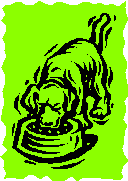Who Paid For That Food, Anyway?
Introduction
When a dog has food-related
aggression, he or she will guard his or her food,
treats, rawhides, or bones from other dogs or
people. How the dog shows food-related aggression
can be quite variable. Some dogs begin to growl
softly from a great distance and increase the
intensity of their growling as people approach. Some
dogs growl while shaking and gulping their food.
Some dogs stare and snarl at anyone within their
view while eating.
Treatment of Food Bowl
Aggression
Once a dog
over the age of seven months has
developed a habit of food
guarding, it is not always
possible to correct this
behavior or it may require the
assistance of a professional.
Some dogs become so firmly
entrenched in this habit that it
is necessary to simply not allow
anyone near the dog while he or
she is eating. However, if food
bowl aggression is noticed early
on, then use the following steps:
steps:
1. Watch for "stiffening" of the body.
This is a warning that you are in danger of being bitten, so stop
the session and come back to it later.
2. Begin feeding the dog
in a different food area.
3. Make the dog "Sit,
down, and wait" before putting down the food bowl.
4. Put down an empty
bowl, ask the dog to "Sit,"
then hand feed individual
pieces of kibble. After this, ask the dog to
earn
each piece of kibble for
at least the first 10 pieces by sitting or lying
down, staying, coming, or following another Instruction.
5. If the dog will not work for
the kibble, put the food away and try again later when the dog is
hungry and more food motivated.
6. After the dog has earned the
first 10+ pieces of kibble, bring your hand towards
the empty food bowl, drop one piece of kibble in the
bowl, and then allow the dog to take it. Next, have
the dog sit and stay again while you drop the next
kibble in. Don't allow the dog to go to the kibble
until you give permission (i.e., using a releaser
word like," Okay").
7. During this time, have a
leash on the dog, preferably with a
head collar.
Do not grab the dog by the collar. Use the leash-collar combination
to pull the dog back if he or she goes toward the food before you
give permission. After you give permission, allow him or her to go
to the food bowl to get the food treat.
8. Next, put several pieces
of kibble in the food bowl. Allow the dog to eat
some of it. Then, while there is still kibble in the
food bowl, offer a food treat that is more desirable
than the kibble, such as a piece of chicken or
cheese. Do this by having the dog sit. Drop the food
treat in the food bowl.
 Instead
of being anxious around the food bowl, you want the
dog to feel happy and relaxed when you, your hand,
or other people that approach the food bowl. The
goal is to help the dog to let go of any suspicions
(a conditioned emotional response) and realize that
humans really don't steal dog food and eat it.
Instead
of being anxious around the food bowl, you want the
dog to feel happy and relaxed when you, your hand,
or other people that approach the food bowl. The
goal is to help the dog to let go of any suspicions
(a conditioned emotional response) and realize that
humans really don't steal dog food and eat it.